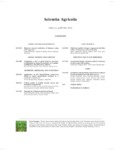Por favor, use este identificador para citar o enlazar este ítem:
http://www.alice.cnptia.embrapa.br/alice/handle/doc/930067Registro completo de metadatos
| Campo DC | Valor | Lengua/Idioma |
|---|---|---|
| dc.contributor.author | SANTOS, P. M. | pt_BR |
| dc.contributor.author | THORNTON, B. | pt_BR |
| dc.contributor.author | CORSI, M. | pt_BR |
| dc.date.accessioned | 2012-07-31T11:11:11Z | pt_BR |
| dc.date.available | 2012-07-31T11:11:11Z | pt_BR |
| dc.date.created | 2012-07-31 | pt_BR |
| dc.date.issued | 2012 | pt_BR |
| dc.identifier.citation | Scientia Agricola, v. 69, n. 5, p. 293-299, sep./oct. 2012. | pt_BR |
| dc.identifier.uri | http://www.alice.cnptia.embrapa.br/alice/handle/doc/930067 | pt_BR |
| dc.description | Dry mass production and persistence of Panicum maximum pastures depends on nitrogen supply. Defoliation influences N uptake and allocation patterns yet its effects on plasticity of N dynamics in P. maximum have not been investigated. Stable isotopes of N (15N) were used in order to test the hypothesis that defoliation in terms of proportion of the leaf area removed effects N mobilisation, uptake and allocation patterns in P. maximum. The plants were initially cut weekly to a height of either 0.15 m or 0.30 m for seven weeks. Eight weeks after the first defoliation, all plants were defoliated for a final time to remove 0, 25, 50, 75 or 100 % of the area of each individual leaf blade of the main tiller. Root N uptake was reduced when all leaf area was removed, but more lenient defoliation improved N uptake due to a positive effect on specific N uptake. Young leaves, side tillers and roots were the main sinks for N from root uptake. Roots of P. maximum became a net source of N for mobilisation immediately after severe defoliation. Root uptake was the main source of N for new growth in P. maximum plants. Allocation pattern of mobilised N was different from that of N derived from root uptake. It was concluded that adaptation of P. maximum to defoliation is related to plasticity of N uptake, mobilisation and allocation, but changes in N dynamics did not offset negative impacts of complete defoliation of the plants. | pt_BR |
| dc.language.iso | eng | pt_BR |
| dc.rights | openAccess | pt_BR |
| dc.subject | Clipping height | pt_BR |
| dc.subject | Guineagrass | pt_BR |
| dc.subject | Organic reserves | pt_BR |
| dc.subject | Tropical grass | pt_BR |
| dc.title | Adaptation of the C4 grass Panicum maximum to defoliation is related to plasticity of N uptake, mobilisation and allocation patterns. | pt_BR |
| dc.type | Artigo de periódico | pt_BR |
| dc.date.updated | 2016-03-07T11:11:11Z | pt_BR |
| dc.subject.nalthesaurus | regrowth | pt_BR |
| riaa.ainfo.id | 930067 | pt_BR |
| riaa.ainfo.lastupdate | 2016-03-07 | pt_BR |
| dc.identifier.doi | https://doi.org/10.1590/S0103-90162012000500002 | eng |
| dc.contributor.institution | PATRICIA MENEZES SANTOS, CPPSE; BARRY THORNTON, THE JAMES HUTTON INSTITUE/ ABERDEEN; MOACIR CORSI, PROF. DO DEPARTAMENTO DE ZOOTECNIA - ESALQ/PIRACICABA. | pt_BR |
| Aparece en las colecciones: | Artigo em periódico indexado (CPPSE)  | |
Ficheros en este ítem:
| Fichero | Descripción | Tamaño | Formato | |
|---|---|---|---|---|
| PROCI2012.00099.pdf | 587,02 kB | Adobe PDF |  Visualizar/Abrir |









